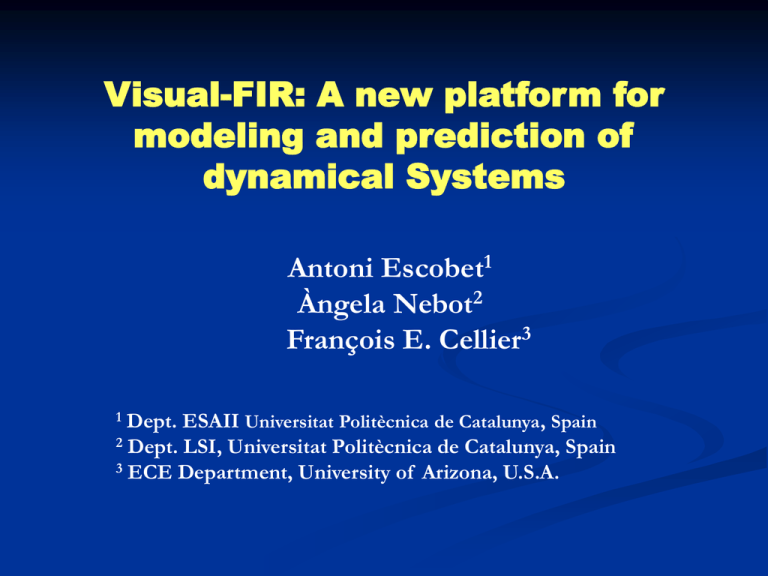Diapositiva 1
advertisement

Visual-FIR: A new platform for modeling and prediction of dynamical Systems Antoni Escobet1 Àngela Nebot2 François E. Cellier3 1 Dept. ESAII Universitat Politècnica de Catalunya, Spain 2 Dept. LSI, Universitat Politècnica de Catalunya, Spain 3 ECE Department, University of Arizona, U.S.A. Introduction Fuzzy Inductive Reasoning (FIR) is a pattern-based modeling methodology operating on observations of system behavior rather than structural knowledge. It is a useful tool for modeling and simulating systems, for which no a priori structural knowledge is available. When using FIR, the modeler had to write M-functions, in which the various FIR modules were called one after the other. Since FIR can be used in many different ways, the user interface was kept at a relatively low software level. In the research effort described in this paper, a new platform for the FIR methodology is designed and developed under the Matlab environment. The new tool, named Visual-FIR, allows the identification of dynamic systems models in a user-friendly form-driven environment. Fuzzy Inductive Reasoning Fuzzy Inductive Reasoning Optimal Mask Optimal Mask (Maximum Q value) t\x t-2 t t- t t u1 u 2 y 0 -1 0 0 0 -2 -3 0 +1 Fuzzy Inductive Reasoning Visual FIR The Visual-FIR platform is described by means of an application from biology, concerning shrimp farming. The goal is to identify growth models for occidental white shrimp (Penaeus vannamei) in semi-intensive farming. Visual FIR Model identification phase. Configuration of the parameters Loading of the training data Recoding the data Identification of the optimal mask Visual FIR Configuration of the parameters Membership functions: Gaussian Triangular Confidence measure: Proximity Similarity Prediction distance measure Weight equations Optimal mask search algorithms Miss_data parameter etc… Visual FIR Loading of the training data 1. the training data 2. Load 3. 4. Complete Select Visualize input variables setand of training output and file save variables data data file Visual FIR Recoding the data 2. 1. List 3. 4. 5. Readofthe Select Generate Recode the all : Conversion training the the discretization output variables data file offile (input the algorithm quantitative and output) for each datavariable into qualitative triples A large number of discretization (clustering) algorithms, both hierarchical and non-hierarchical, are offered to the user . Visual FIR Optimal mask 3. 4. 2. 1. Select Mask Candidate search depth and save mask definition the configuration mask Visual FIR Prediction phase. Loading of the testing data Prediction Regeneration Result visualization Visual FIR Loading of the testing data 2. 1. The 3. Loadinput Visualize the test variable anddata output and file variables save dataare fileselected automatically Visual FIR Prediction 1. The prediction button of the main screen must be pushed Visual FIR Regeneration 1. The defuzzification is computed Visual FIR Result visualization 1. Visualize the difference 2. real and predicted betweensignals real and predicted signals and show the error Conclusions In this paper, the Visual-FIR platform was presented. This new tool offers access to the Fuzzy Inductive Reasoning methodology in an effective and user-friendly manner. The FIR methodology offers a model-based approach to predicting dynamical systems with very good results when applied to soft sciences applications. Visual-FIR has the advantage, in comparison with previous FIR implementations, that no code needs to be developed for each new application studied. It is hoped that the new interface will make the FIR methodology accessible to new users, as it makes it much easier to apply the methodology to new applications, and as it makes it much faster to try out different algorithms on one and the same application.




